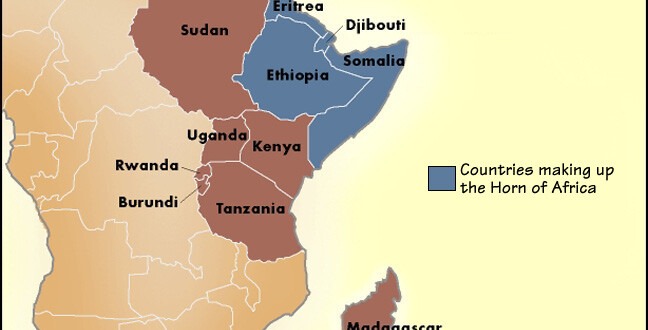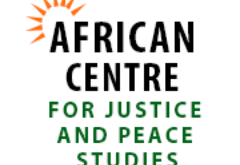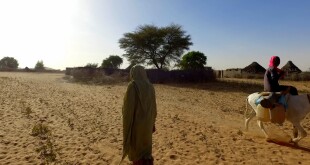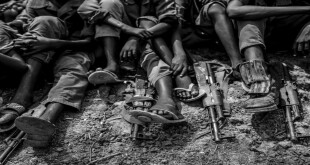(4 August 2022)
Background
In 2018, African Centre for Justice and Peace Studies (ACJPS) developed a report focused on the implementation of anti-human trafficking laws in the east and horn of Africa. The report resulted from a four-day forum on the implementation of anti-trafficking laws in the east and horn of Africa organised by ACJPS for representatives of civil society. Data collected in this report was intended to serve advocacy purposes, both regionally and internationally. [1] On 30th July, ACJPS joined the world in commemorating the World Day Against Trafficking in Persons.
Countries in the East and Horn of Africa for purposes of this brief include Eritrea, Somalia, Ethiopia, Sudan, Kenya, and Uganda. These countries have high number of illegal immigrants whose lack of proper documentation renders them vulnerable to human trafficking. Children, immigrants, refugees, asylum seekers, displaced people, unemployed youth, and women are smuggled through Libya, Egypt then to Europe and beyond.[2]
Human trafficking is defined by the Trafficking Protocol as the recruitment, transportation, transfer, harboring or receipt of persons, by means of the threat or use of force or other forms of coercion, of abduction, of fraud, of deception, of the abuse of power or of a position of vulnerability or of the giving or receiving of payments or benefits to achieve the consent of a person having control over another person, for the purpose of exploitation.[3]
The Laws Against Human Trafficking in the Region and the Legal Framework States Policies
In 2014, the Parliament of Sudan passed the Combating of Human Trafficking Act which was the country’s first law addressing human trafficking the law prohibits trafficking of any kind and provides penalties for human traffickers.[4] The National committee to combat Trafficking launched its first action plan to control human trafficking, in 2017. A specialized Court with a Judge that decides over human trafficking cases, by 2018 the court had prosecuted 30 cases of human trafficking and 45 traffickers convicted.
On 30th August 2021, the National Committee to combat human trafficking inaugurated the National Plan for Combating Human Trafficking 2021-2023 in Khartoum Sudan.[5] Among the measures pointed out in this plan include the following[6]
- more safe houses and secured shelters for rescued victims,
- access to a microfinance programme and to vocational and technical education and job opportunities to reduce poverty and increase livelihood options for young people, including migrants, refugees, and asylum seekers, and
- trainings targeting law enforcement officials, establishment of specialised prosecutor offices and courts, cross border cooperation and access for victims of trafficking to legal aid to improve investigation and prosecution.
The provisional constitution of Somalia prohibited slavery, servitude and forced labour and Article 14. Section 455 criminalizes slavery with a penalty of five to 20 years’ imprisonment
In 2017 November the city state of Puntland in n north-eastern Somalia passed valid human traffic legislative framework, which was made of new laws, criminal procedures, penal codes that specifically prohibit human trafficking.[7]
Ethiopia has also enforced pieces of legislation in the fight against human trafficking. The national legislation prohibits slavery.[8] Its supported by Article 596 of the penal code act which criminalizes enslavement of people. Proclamation no 909/2015 prevention and suppression of trafficking in persons and smuggling of migrants criminalizes exploitation of people within and outside the territory of Ethiopia enshrined.[9] The prevention and suppression of trafficking in persons Proclamation 2015 also criminalizes trafficking in persons.[10]
In 2020 April, the Ethiopian government further enacted the Proclamation 1178/2020 to provide for the prevention and suppression of trafficking in persons and the smuggling in persons.[11]
A National Partnership Coalition for the prevention and control of the crimes of trafficking in person and smuggling of migrants was also convened this has a purpose of fighting trafficking in persons in Ethiopia.[12]
United Nation Convention against transnational organized crime 2002 criminalizes serious crimes which includes human trafficking and has protocols supplementing it.
Firstly, Protocol to prevent suppress and punish trafficking in persons especially women and children. Article 3 defines trafficking in person as Article 5 states that each state party shall adopt laws that criminalized trafficking in person.
Secondly, Protocol against the smuggling of migrants by land sea and air. Article 2 of the protocol states its purpose which is to combat the smuggling of migrants and Article 5 conveys a responsibility on state parties to set up laws that criminalized smuggling of migrants.
The Parlemo Protocol, Universal Declaration of Human Rights and International Covenant for Civil and Political Rights ae all international instruments that prohibit slavery which is carried out through modern day trafficking. These instruments have been ratified by countries in the East and Horn of Africa these countries include Uganda, Tanzania, Kenya, Sudan, Burundi, Ethiopia, Somalia Eritrea among others.
On a regional level, the African Charter on rights and welfare of the child 1990 prohibits trafficking in person especially children under Article 27 and Article 29.
Uganda also has different pieces of legislation in place, against human-trafficking. Article 5 of the 1995 Constitution of the Republic of Uganda, the Penal Code Act Cap120, Section 249 of the Acy, Prevention of Trafficking of Persons Act 2009, Immigration Act Cap 63, Passport Act 1982 Cap 64, and the Extradition Act 1964 Cap 117, provide for protection from trafficking, illegal migration, slavery servitude and forced labor.
The domestic laws in Kenya are also enforcing anti-human trafficking through the Counter Trafficking in Persons Act of 2010 Chapter 61, in compliance with the UN Convention Against Transnational Organized Crime. In addition, the Sexual Offences Act of Kenya enacted in July 2006 prohibits trafficking of children and adults for sexual exploitation
The following framework policies and strategies have been established in Kenya. Civil Society Organizations to join in the fight against human trafficking like Trafik -Kenya. A CTIP Secretariat has been established to coordinate and carry out anti human trafficking activities in Kenya on behalf of the advisory committee Development of the National Referral Mechanism guidelines which coordinate multi agency response
The Kenyan Ministry of Labour Social Security and Services assigned labour attached to Kenyan missions in Kuwait, United Arab Emirates and Saudi Arabia to protect citizens employed in these countries.
The Perpetrators
In the case of Sudan, traffickers have been reported to be strategically on the boarders and camps where they either kidnap or buy the smuggled immigrants and unaccompanied children. Forced labour in gold mines is said also be sourced from trafficking both immigrants and Sudanese nationals, especially beggars, who are found vulnerable to being subjected to it. Sudan investigated 99 total trafficking cases involving 177 suspected traffickers. 94 were prosecuted and only 7 were convicted under the anti-human trafficking law.[13]
Government officials responsible for combating human trafficking, politicians and foreign tourists are reported to be the perpetrators of human trafficking in Kenya. Forced labour and sex abuse are the most common forms of exploitation by human traffickers in Kenya. Unskilled labour is taken to the Middle East regions for domestic and sexual exploitation, while religious groups have also been reported to sexually abuse children taken to missionary schools.[14] Sex slavery is also a common trafficking goal on the coast, where parents sell their children to foreign tourists for money.
In Uganda, overseas job-recruitment agencies are highest form of cross-border human trafficking. Kuwait, Malaysia, Oman, United Arab Emirates, China, Thailand, Qatar, Iraq, India, Saudi Arabia, Lebanon, Syria, United Kingdom, United States of America,Germany, Czech Republic, Turkey, Saudi Arabia, and South Africa among others, have been reported to be among the common destinations.[15]
Victims
In Kenya the forum reported about 600 children sex trafficking to be the highest form in Kenya. Poverty stricken families sell their children at price, while aware of the possibility of their sexual exploitation. A missionary school was also investigated on claims of sexual abuse by the priest, against the orphans who had been internally trafficked and others from neighbouring countries.[16]
High rates of unemployment have largely contributed to human trafficking of unskilled workers for domestic labour and sexual exploitation. Desperate people are coerced into travelling abroad in large groups, to find employment in the Middle East region, unknowingly falling into this trap.
Challenges
Geographical location has proved to be one of the major challenges in combating human trafficking. Traffickers in Sudan operate along the borders, where immigrants are usually transiting through or heading to. Immigrants from the East and Horn of Africa use Sudan borders as their key route. This then becomes an area of operation.[17]
Government officials, security officers, and the police who have been put in place to fight human trafficking have been working with the traffickers for personal gains. They enable the movement of kidnapped immigrants across borders and allow vulnerable potential victims to access the high-risk areas.[18] These officials also avoid accountability as they’re granted immunity by the National Security legislation.[19]
CSOs have also faced challenges in accessing and operating in human trafficking areas due to the restrictive laws and policies enforced by the regional police.
The regional laws are not sufficient as the definitions of what constitutes exploitation are insufficient. Proving trafficking poses a challenge for officials due to the complexity of the crime.
These countries host large numbers of refugees in camps, who are always increasing every year. Ethiopia hosts thousands of refugees from Sudan, Eritrea, and Somalia.[20]
Poverty is also a great challenge and many fall victim to the human trafficking in the pursuit of a better life or better employment opportunities abroad.
The lack of awareness about human trafficking is also a contributing factor in most of the key areas. Parents selling their children under the assumption that they will leave a good life, unaccompanied minors and vulnerable illegal immigrants accepting to travel abroad under the promise of a better life increases their chances of falling victim to trafficking.
Another challenge Uganda reported was the difficulty to investigate and track disappearances, as many of these people are undocumented and unknown to the authorities. This makes them an easy target for traffickers.[21]
Uganda also reported the difficulty in authorities carrying out oversight roles on the overseas job recruitment agencies as they attain permits of operation through corruption.
Chances To Fight Against Human Trafficking
Most of the countries including Sudan, Ethiopia, Kenya, and Uganda among others, are acceded to the UN Anti-Human Trafficking Protocol, after which an Anti-Human Trafficking Act was enacted. Sudan then established a national committee to combat human trafficking, but funding for operation has since been a challenge.
A human trafficking and combat unit in the Police of Sudan that deals with investigating trafficking crimes and rescuing victims of human trafficking was enforced. Safe houses have also been established by the Prosecuting Attorney with the help of the UNHCR and Danish Red Cross these safe houses are to protect victims of trafficking from suspects and convicts of human trafficking.
The Ugandan Ministry of Gender, Labour and Social Development has enforced restrictive policies and measures for transparency and accountability on the job recruitment agencies to combat chances and opportunity for human trafficking.[22]
Uganda has and continues to intercept and rescue over 1000 girls and boys who have been rehabilitated and reunited with their families since 2014.[23]
Recommendations
- There is need for sub-regional law enforcement and mechanisms to combat the trafficking in the trafficking hotspots.
- Strict regulation of the overseas employment agencies which have high chances of being human trafficking agents.
- More sensitization workshops in the refugee camps and coastal regions should be held to bring awareness about what human trafficking is, how it works, and its consequences.
- CSOs are encouraged to negotiate and work with the government in order to bypass difficult regional restrictions and have access to data.
Way Forward
Several measures were discussed and reported at international, regional, national levels and in the civil society. These included conducting regular policy advocacy with members of international community, ensuring regional institutions commitment to tracking and reporting, advocating and lobbying for enactment and enforcement of legislations, raising awareness/sensitizing decision-makers, pursuing the human trafficking through the national Universal Periodic Review process, engaging on tracking and reporting state commitment, engaging on regular policy briefing and legislation reforms, and establishing civil society online report website.[24]
[1] African Centre for Justice and Peace Studies “Civil Society Forum on the Implementation of Anti-Human Trafficking Laws in the Horn and East of Africa” Forum Report 2018 pg3.
[2] African Centre for Justice and Peace Studies, Forum Report 2018 pg4.
[3] Article 3 of the 2000 Protocol to Prevent, Suppress and Punish Trafficking in Persons, Especially Women and Children.
[4] Chapter 3
[5] Reliefweb “Sudan inaugurates new plan to combat human trafficking” published on 31st August 2021 https://reliefweb.int/report/sudan/sudan-inaugurates-new-plan-combat-human-trafficking#:~:text=August%2030%2C%202021%20(KHARTOUM),from%20the%20Horn%20of%20Africa. Accessed on 31st July 2022.
[6] European Commission News “Sudan responding to the challenges of human trafficking” published on 30th August 2021 https://ec.europa.eu/trustfundforafrica/all-news-and-stories/sudan-responding-challenges-human-trafficking-country_en accessed on 31st July 2022.
[7] Madeline Drayna “Examining human trafficking in Somalia” Borgen Project https://borgenproject.org/human-trafficking-in-somolia/ accessed on 31st July 2022.
[8] Article 18(2) of the Constitution of the Federal Republic of Somalia, 2012.
[9] Article 1 of Proclamation no 909/2015.
[10] Article 13 of Proclamation no 909/2015.
[11] U.S. DEPARTMENT of STATE “2021 Trafficking in Persons Report: Ethiopia” https://www.state.gov/reports/2021-trafficking-in-persons-report/ethiopia/ accessed on1st August 2022.
[12] Enact “Human trafficking/Combating human trafficking and migrant smuggling in Ethiopia more effectively” published on 26th August 2021 https://enactafrica.org/enact-observer/combating-human-trafficking-and-migrant-smuggling-in-ethiopia-more-effectively#:~:text=Recently%20Ethiopia%20has%20made%20strides,suppression%20of%20TIP%20and%20SOM. Accessed on 1st August 2022.
[13] Unites States Department of states, Human trafficking Report on Sudan, 2018,
https://www.state.gov/j/tip/rls/tiprpt/countries/2018/282755.htm. Accessed on 1st August 2022.
[14] African Centre for Justice and Peace Studies, Forum Report 2018 pg12.
[15] National Action Plan for Prevention of Trafficking in Persons in Uganda, 2015.
[16] fn 5.
[17] Forum Report 2018 pg7.
[18] Ibid.
[19] Forum Report 2018 pg21.
[20] Forum Report 2018 pg9.
[21] Forum Report 2018 pg23.
[22] The Independent (Kampala) “Uganda: MPs Ask Govt to Protect Domestic Workers Abroad” All Africa 29th July 2022 https://allafrica.com/stories/202208010191.html accessed on 2nd July 2022.
[23] Forum Report 2018 pg25.
[24] Forum Report 2018 pg48.
 African Centre for Justice and Peace Studies ACJPS | المركز الافريقي لدراسات العدالة و السلام
African Centre for Justice and Peace Studies ACJPS | المركز الافريقي لدراسات العدالة و السلام




